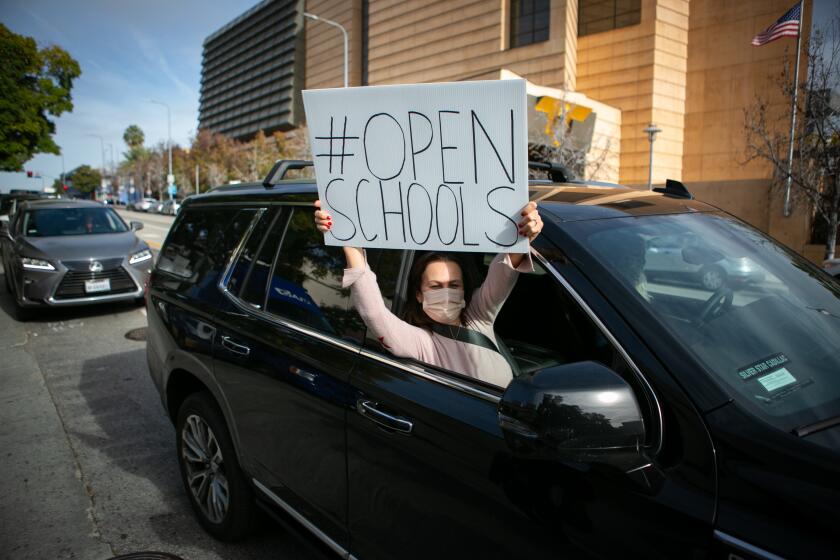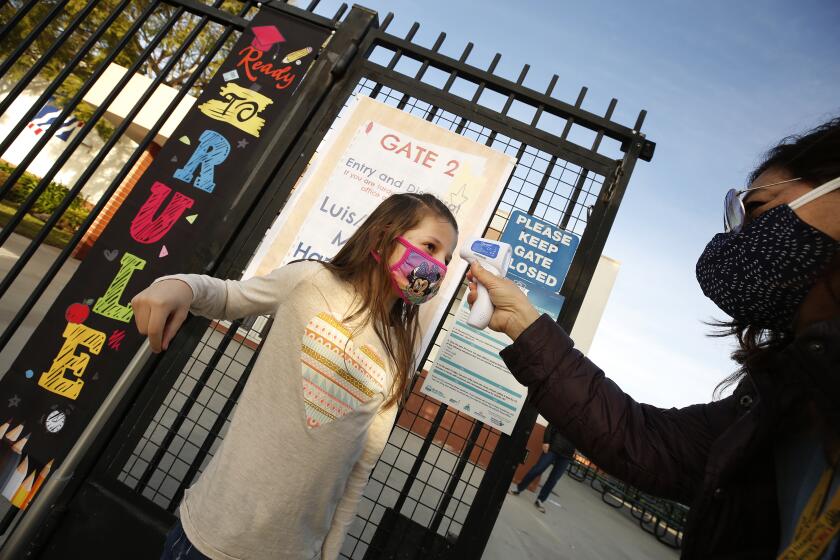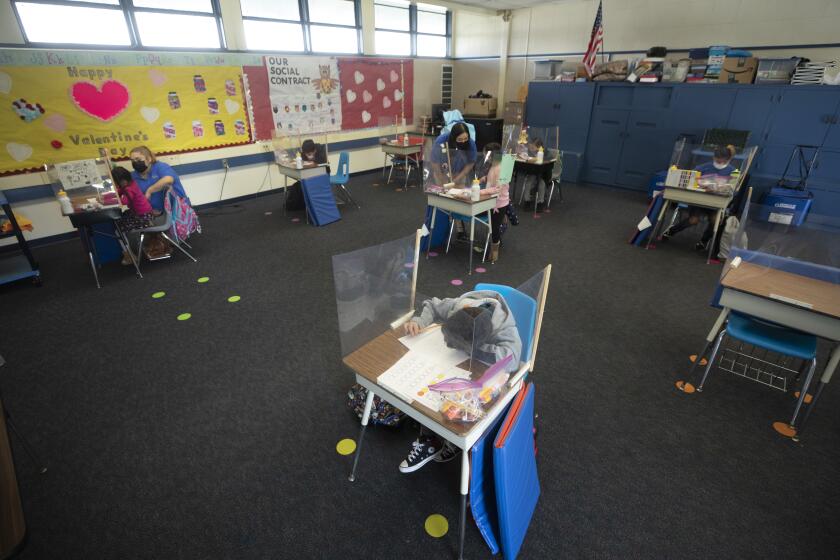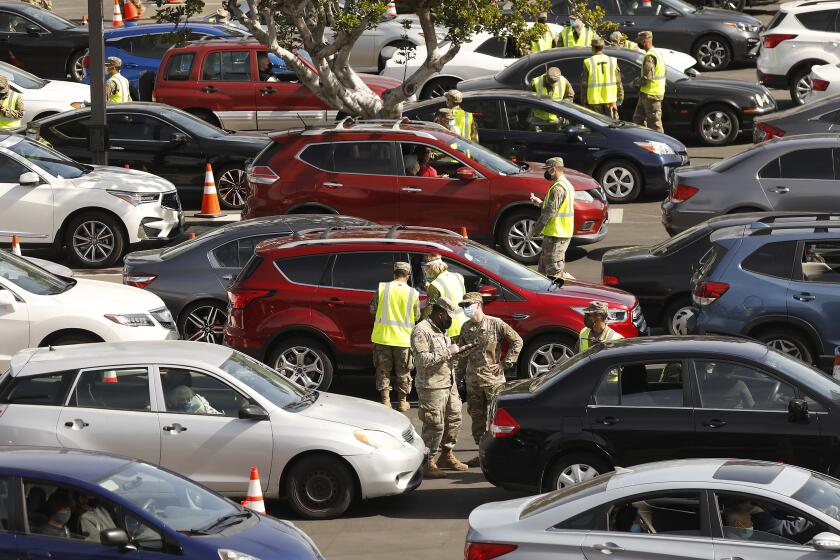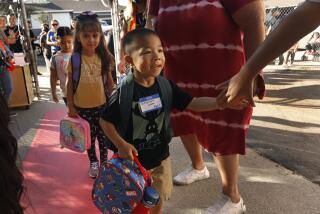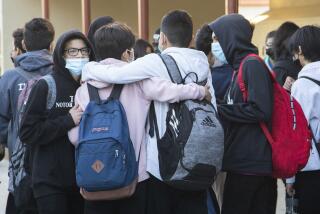L.A. elementary schools can finally reopen, but it will be complicated, uneven
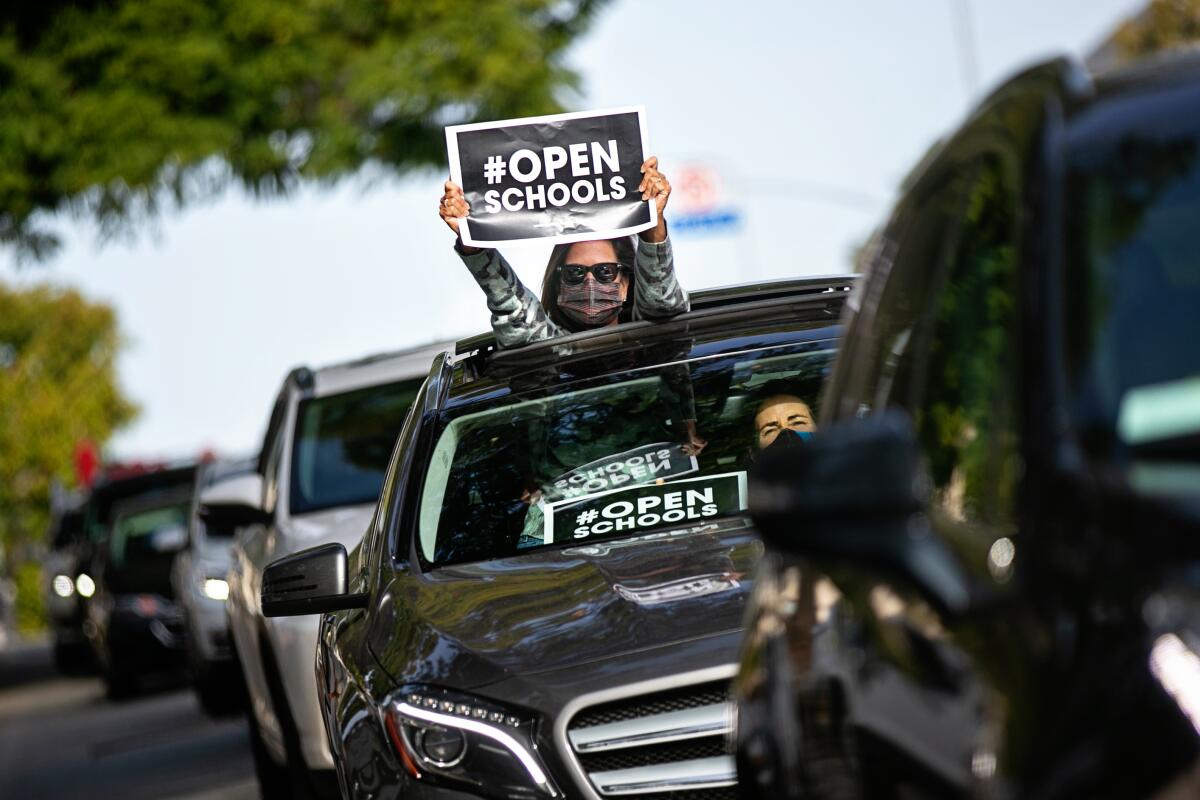
- Share via
The announcement this week that Los Angeles County coronavirus rates have finally dropped low enough to allow for the immediate reopening of elementary schools is leading to an uneven return to class — fast in districts serving more affluent communities, but just one step in an arduous climb for school systems elsewhere, including in L.A. Unified.
Both school leaders and families face difficult choices after pandemic-forced school closures nearly a year ago upended the education of about 1.5 million students in L.A. County and about 6 million statewide. Every school system has the authority to decide how far to go when reopening elementary campuses — and how soon.
L.A. County elementary schools are cleared to open, officials confirmed Monday, based on new infection numbers. Meanwhile, the first COVID-19 vaccination site based at an L.A. school will open this week, targeting school district employees.
Smaller school systems in more prosperous communities — and many private schools — appear poised to quickly expand in-person instruction; many have been calling for it. But in larger districts and those serving mainly low-income areas, concerns about vaccinations for school staff and community anxiety over health risks are making for harder decisions.
“Who wouldn’t celebrate the fact that the numbers are coming down and schools now have the ability to reopen?” said Debra Duardo, superintendent of the L.A. County Office of Education, which offers services and support for 80 county school districts. But “it’s very different depending on what community you’re talking about. In poorer neighborhoods that are disproportionately impacted, where families have had higher exposure to COVID, where children have had family members sick or dying, it’s a different experience.”
Ultimately, she added, it’s a local decision based on the readiness of all concerned, including the school system’s ability to operate safely. Before any campus can reopen the district must have a detailed safety plan filed with the state and county — health authorities have seven days to raise objections. Some districts and independent schools already have had plans on file.
A Times survey of over 20 school districts found that those in wealthier, whiter communities were more likely to be moving full steam ahead to reopen elementary schools.
Elementary schools can reopen because the coronavirus infection rate has been below an adjusted rate of 25 daily cases per 100,000 residents for five consecutive days. For middle and high schools to reopen, rates must fall to seven cases or below per 100,000.
The rapid change of status caught many in education by surprise, including members of the Los Angeles Board of Education, who were personally alerted Tuesday by county Public Health Director Barbara Ferrer, who fielded their questions at a school board meeting.
“At this point you know today — if [you] wanted to open up all of your TK through grade six classrooms for in-person instruction — you’ve actually completed the paperwork,” Ferrer said.
The previous morning, on Monday, L.A. schools Supt. Austin Beutner had said that the district could not, per state rules, legally reopen campuses for all students — and at that moment he was correct. The county officially confirmed the revised reality that night.
No one, however, is celebrating in the leadership of the nation’s second-largest school system, where 80% of students qualify for a free- or reduced-price lunch because they are members of a poor or low-income family.
At the meeting, board member Jackie Goldberg wanted to know why teachers could not be immediately prioritized for vaccination, especially those serving the youngest students. Goldberg noted that some teachers are getting vaccinated in other jurisdictions, including Long Beach.
Ferrer replied that there simply aren’t enough doses to go around. She said the current target date for school workers is March 1, when, she hopes, the vaccine supply will be greater.
A proposal by Councilman Joe Buscaino to pursue litigation forcing L.A. Unified to reopen campuses receives cool reception from other city officials.
Others who would qualify at the same time include essential food-industry workers, law enforcement officers and other first responders — part of a group that totals about 1.8 million, Ferrer said. All of them, she added, have a strong claim to needing the vaccine as soon as possible.
Currently, the county is receiving about 200,000 doses a week; the vaccine requires two doses and about five to six weeks to achieve maximum immunity. Ferrer said she appreciated Beutner’s push for vaccines for school employees, including a proposal for a mass vaccination site for these workers at SoFi Stadium in Inglewood, but the overriding problem is supply.
Health authorities do not require vaccines as precondition to reopen, but school-employee union leaders in Los Angeles and elsewhere say it’s essential. They also want to see case rates decline further, waiting until the county exits the “purple tier,” a designation that signifies widespread community transmission of the infection. On Tuesday, the teachers union cited the potential risk to students — who are nowhere near vaccine eligibility — and their families.
“Educators cannot support a broad physical reopening of schools until school staff required to work in person have access to vaccinations, L.A. County is out of the purple tier and reaches much lower community transmission rate, and all schools have strict multi-layered mitigation strategies in place,” according to a statement from United Teachers Los Angeles.
The quandary extends to school districts across much of L.A. County, including to the El Monte City School District, with about 8,000 students, less than 2% the size of L.A. Unified.
Some essential workers, teacher eligible for vaccine in L.A. County beginning March 1
“We are happy to see county rates decrease,” said El Monte district spokesman Robert Dozmati. “We look forward to seeing rates in El Monte decrease as well.”
The district, with a poverty rate of 93%, has reconvened a reopening task force with administrators, teachers, nonteaching staff and parents. But “not much has changed for us in recent weeks.”
He added: “At this moment, we have no timetable,” but “we will be ready to reopen when we decide it is safe enough.”
At another extreme is the Las Virgenes Unified School District, with a poverty rate of 12%, which straddles the border of Ventura County. Las Virgenes plans to have all elementary schools operating in person by March 1 and Supt. Dan Stepenosky said he wishes he could move even faster.
“None of this is easy, but by coming together, we can dramatically increase the benefits for all children and safety for staff and students,” Stepenosky said.
Similarly, in Palos Verdes Peninsula Unified, with a poverty rate of 8%, Supt. Alexander Cherniss already was returning students to campus as aggressively as he felt the rules allowed. High school sports teams resumed modified practices on Feb. 1. He also has brought back students to participate in drama, speech and debate and music extracurriculars. He is lobbying officials to bring back all grades for in-person instruction without further delay.
Santa Monica-Malibu Unified, with a poverty rate of 27%, is taking a different path.
Officials this week announced a tentative agreement with their teachers union that would require vaccines to be available to school staff for 15 days prior to students returning. At that point, all K-12 students would gradually return to campus, if they wish, for enrichment activities, which might include club meetings or outdoor learning projects. Even while the county remains in the purple tier, elementary students are likely to have the option of up to two days of instruction on campus. District leaders say that allowing students to socialize and spend time together is of prime importance.
Every decision being made at a school or district level also is playing out family by family.
Rogelio Rivas, 40, who has two children in an Inglewood elementary school, said he doesn’t yet feel safe sending his children back to campus.
He worries about children bringing the virus to teachers or back home to families in communities already devastated by the pandemic.
“The bottom line is Inglewood is mostly brown and Black kids whose parents are essential workers,” he said. “If you send your kids into a school and they bring the virus back to your family where there’s multiple generations living, it’s scary.”
He also worries about how working parents would cope if schools reopen and are forced to close again because of an outbreak.
In Inglewood Unified, with a poverty rate of 83%, 71% of families recently surveyed said they did not yet feel comfortable “sending their child back to school” even if permitted to do so.
Stuart Waldman, who has three girls in elementary school in nearby Manhattan Beach wants schools to fully reopen soon.
The Manhattan Beach district, with a poverty rate of 5%, already is allowing students on campus up through second grade, under a county-approved waiver. His fourth-grader has been waiting on the sidelines.
Waldman’s second-grade twins are in class on campus 10 hours a week, a part-time schedule worked out to comply with safety protocols, which include small, socially distanced classes. Such safeguards remain essential, health officials said.
Those 10 hours on campus are not enough, Waldman said.
“I’m hopeful that this can help,” he said of the opportunity for an expanded reopening. However, “at this point, I’ve pretty much lost hope on this year. ... I’m more focused on next year. We have to figure out a way to teach them in a somewhat normal environment.”
More adamant was Los Angeles parent Ross Novie, who took part in a rally Monday demanding the reopening of campuses.
“California has been cursed with the worst leadership at the worst time,” Novie said. “History will consider not opening schools as one of the worst public policy fiascos of all time.”
More to Read
Sign up for Essential California
The most important California stories and recommendations in your inbox every morning.
You may occasionally receive promotional content from the Los Angeles Times.
